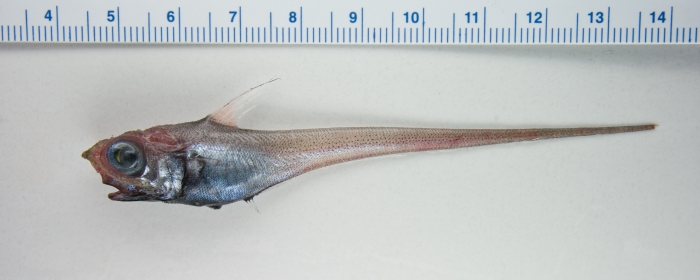
SIZE:
Jusqu’à 40 cm.
LIFE EXPECTANCY:
Jusqu’à 11 ans.
LIFE CYCLE:
The marlin-spike is a sexually reproductive species.
Males and females release their reproductive cells into the water column during the breeding season, which takes place in summer and autumn.

The marlin-spike is a small fish with an elongated body.
Credit: Claude Nozères, photo taken in 2010.
The marlin-spike has a large head, a pointed snout and very large eyes that are well adapted to the low-light conditions in deep waters. Its long body tapers sharply to a whip-like tail. It is greyish brown with a dark blue belly. It has a silver stripe along its lateral line. The dorsal fin is tall and triangular with a long, serrated spine.
Found in the water column and near the bottom, down to 2295 m depth.
The marlin-spike is usually found at temperatures between -2 °C and 16 °C.
PREYS:
Plankton
Small crustaceans
Marine worms
PREDATORS:
Halibut
Swordfish
Belugas
No commercial fishing.
The marlin-spike is often an incidental catch by trawlers in deep-sea fishing (shrimp fishing).
Although the marlin-spike is not targeted by the fishing industry and its area of distribution is extensive, the status of its populations remains poorly understood. Further research is needed to assess its vulnerability to overexploitation and other threats.
Marlin-spike is a Smarter seafood-listed species.
BENEFITS:
This oily fish is rich in omega-3 fatty acids and is a source of protein, iron and sodium. It has a low lipid content.
LET’S COOK:
Delicate flesh with few bones. Its taste is similar to that of cod, although more subtle.
OUR CULINARY ADVICE:
- When purchasing, the skin must be shiny and the eyes bright.
- Best to use gentle cooking methods, such as steaming or poaching.
- Slow cooking is also appropriate, for example in a stew.
- The marlin-spike can also be eaten raw, in tartar or ceviche, with a little lemon juice and aromatic herbs.






